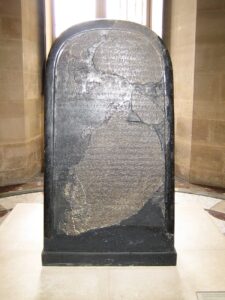Queries and Comments: Human Sacrifice and Circumcision, Biblical Archaeology Review (13:2), Mar/Apr 1987.

Mesha Stele. By Henri Sivonen from Helsinki, Finland – Mesha Stele, CC BY 2.0, https://commons.wikimedia.org/w/index.php?curid=4761690
“Why King Mesha of Moab Sacrificed His Oldest Son,” BAR 12-06, graphically describes the Canaanite rite of human sacrifice when siege or pestilence threatened to exterminate a city. The text attributed to the Phoenician priest Sanchuniathon that author Baruch Margalit cites makes clear that the practice of circumcision is directly related to this rite of human sacrifice. We learn there that once, when destruction threatened his city, the god El offered his only son as a sacrifice to his father, the god Heaven; he also circumcised himself and ordered his followers to do the same. Circumcision is thus a substitute for human sacrifice, an offering of a part of the body in place of the whole. In Canaanite religion, it served as a reminder to El of the offering of his own son that he himself had performed.
In the Bible, circumcision is described as a “sign” of the covenant between Israel and its God. Nowhere, however, is a reason given for the choice of this particular rite as such a sign. The Canaanite material gives us the rationale for this practice. Israel took over from the Canaanites the conviction that, by offering this part of the body in place of the whole, the life of the individual, and of the entire community, would be preserved.
Roy A. Rosenberg
New York, New York
Excerpted from Queries and Comments: Human Sacrifice and Circumcision in the online Biblical Archaeology Society Library.



